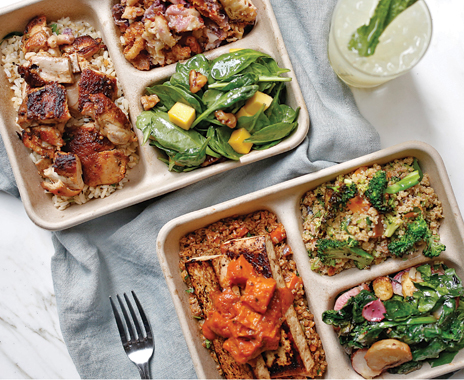Billed as a “farm-to-counter” concept, Dig Inn leaves the last few steps of the “farm-to-table” journey up to the customer in order to make local, seasonal food more affordable.
Founder Adam Eskin says Dig Inn is committed to sourcing naturally raised meats and local seasonal produce, as well as cooking from scratch each day and bringing it all to guests at a reasonable price. “We have a full-service kitchen with a fast-casual front of house,” he says.
What exactly do Dig Inn guests dig into? The menu is divided into three sections: Marketplates, Sandwiches, and Salads. Marketplates come in two sizes and consist of a protein with two sides on a bed of grains or greens. Protein choices include chicken, meatballs, salmon, grilled organic tofu, or steak. Sides vary by season but often include choices like roasted kale, roasted sweet potatoes, or grilled squash. Grains include brown rice and bulgur.
Many of those same ingredients are used in the Salads and Sandwiches, such as the Cluk’n’kale sandwich made with teriyaki chicken, sweet potato, kale, Feta, and tomato on ciabatta bread.
Eskin is not a chef or a farmer. He worked in finance and private equity before getting into the restaurant business. But he was always interested in healthy eating and leaped at the opportunity to invest in a group of five restaurants called Pump Energy Food, which catered to body builders. Eskin thought more could be done with the concept, so he repositioned the brand and renamed it Dig Inn.
“The idea of sharing a meal is very special,” Eskin says. “It has to be delicious. We’re not in the business of deprivation or prescribing a diet. We’re about serving great food and delivering great service.”
Eskin says that while the protein choices on the Dig Inn menu are mostly stable, the vegetable choices are dictated by seasonal availability. Dig Inn also has the flexibility to do limited-time promotions with suppliers and other brands, such as the August partnership with Luke’s Lobster, which added a $17 lobster bake with lobster tail, red potatoes, corn on the cob, and kale to the Dig Inn menu.
Dig Inn
Founder/CEO: Adam Eskin
Rob McColgan
HQ: New York City
Year Started: 2011
Annual Sales: Undisclosed
Total Units: 11
Franchise Units: 0
The challenge of offering locally grown produce in a fast-casual setting is time, Eskin says.“Every year you get one shot at the season,” he says. “Maybe a vegetable comes in and we’re not satisfied with supply; it’s an annual process and it takes time. It’s very relationship driven. We don’t just work with a distributor; we control all the relationships with all of our suppliers.”
To assist in managing the produce supply, Dig Inn built a 12,000-square-foot commissary, allowing the brand to bring in, wash, and repackage larger volumes of produce for individual restaurants.
Another challenge that Eskin says Dig Inn faces is the consumer perception of season. For example, watermelon is not locally available until late July or August, but people see it in grocery stores in June. Furthermore, Eskin doesn’t draw a line in the sand and say Dig Inn buys 100 percent of its produce within a specific distance.
“That’s not practical,” he says. “We can’t dictate seasons and weather patterns. We do our best to deliver our promise of locally grown, but in the off-season, we have to go outside of the Northeast.”
Eskin adds that some types of produce grow better in other parts of the country, such as sweet potatoes in South Carolina. Although local is often the answer for freshness and supporting the local economy, he says, transparency is most important.
Chicken is the top-selling protein. As for vegetables, those South Carolina sweet potatoes are consistently good sellers, and the locally grown Brussels sprouts are hugely popular when they are in season.
“We provide staples and familiar items with simple preparation, but we get the execution right every day for about $10 a person,” he says.
Eskin says he “wouldn’t feel good” about serving big-name soft drinks alongside Dig Inn’s fare, so beverage choices consist of cold-pressed juices, brewed iced teas, and lemonade. He’s also dabbling with beer and wine at some locations but is not certain if alcoholic beverages will be part of the program moving forward.
The lunch/dinner split at Dig Inn is about 65/35, but that is slowly changing.
“Our food is dinner-friendly, and we’re increasing dinner sales now because we are selecting sites that are more balanced,” Eskin says. “Before, we were selecting midtown and downtown lunch-heavy sites.”
The majority of Dig Inn sales are carryout, which Eskin says is driven by being in an urban environment. Locations vary, but all are 1,000–3,000 square feet.
Dig Inn is preparing to venture beyond Manhattan, with cities like Boston, Chicago, Washington, D.C., and Philadelphia being evaluated for potential locations. Eskin says 2016 will be the year that Dig Inn lays the foundational groundwork when it opens in one to two new markets.
He adds that while he’d like to see the number of Dig Inn locations hit 100 in the next five to 10 years, there are no plans to franchise. “We’re still tweaking and refining,” he says. “We’re not ready to hand over the keys.”

